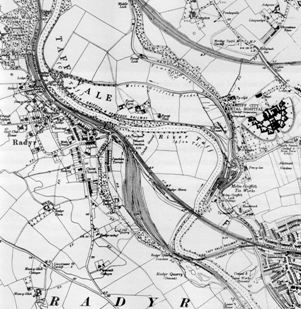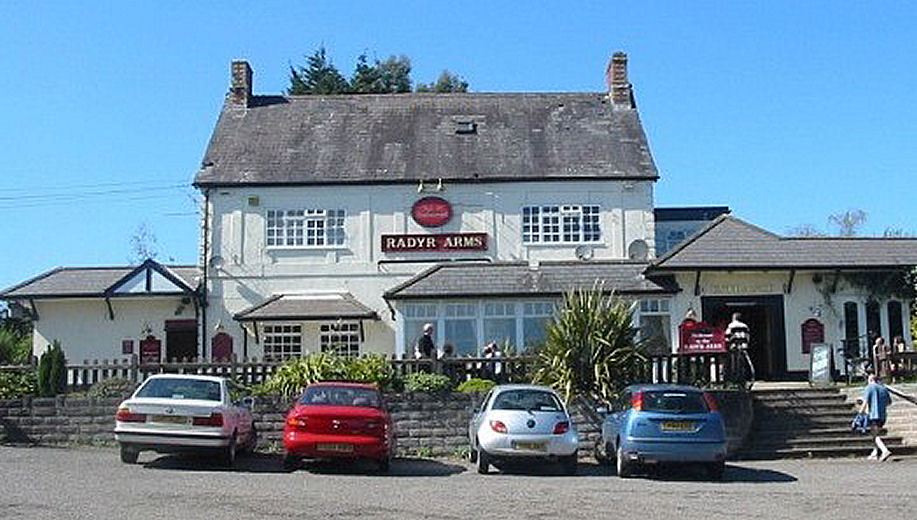THE HISTORY OF CARDIFF'S SUBURBS
RADYR AND MORGANSTOWN
Incorporating Danescourt
CONTENTS
Tap or click to open / closeAradur Hen
A small settlement called Aradur Hen came into being in the middle of the 1st Century, consisting of just a few small huts between Llandaff and the woods to the west.
By the 11th Century, this site was being frequently visited by those making a pilgrimage to the shrine of St. Teilo at Llandaff, possibly because of its proximity to a safe crossing across the River Taff.
Radyr most likely takes its name from a corruption of Aradur, which itself is Latin for 'oratorium', or house of prayer.
Source: OS
There is a possibility that the construction of St. John’s Church in the 13th century was to replace a very early chapel which may have stood in Aradur for over 200 years.
Tudor Influences
The only other building of importance during this time was the manor house at Radyr Court.
In 1321, a dispute between powerful families led to an attack which gutted the building. Thomas Mathew, son of Sir David of Matthew of Llandaff acquired the manor by marriage in 1469.
He had it rebuilt and restored to it's former glory. Sir William succeeded him in 1558, and his son, Sir George Mathew, built an impressive deer park at Radyr Court in 1536.
Sir George's son extended the park 60 years later, and Radyr Wood now covers part of the park. Sir George also assumed ownership of the Iron Works in Pentyrch.
However; the Mathews family were not able to sustain their estate due to extravagant spending, and generations of extensive family to support.
As a result, they lost great swathes of land after the Civil War, which were eventually sold off.
The Creation of Morganstown
By the end of the 18th Century, the Plymouth Estate owned most of Radyr, which was little more than a few farms.
The Iron Works in Pentyrch had been operating since the 16th Century, but was now expanding rapidly. New housing was needed for the workers.
In the late 1830's the site of an ancient farm called Ty'n y Berllan was used for building 10 cottages, which were completed by 1841.
This village assumed the name of the farm initially; it was then called Pentre, Pentrepoeth, Treforgan and finally Morganstown.
The only explanation for the name Morganstown is that Ty'n y Berllan farm was owned by a Morgan Williams, who leased his land for the early development of the district.
Beginnings of Industry
In 1859, the railway came to Radyr, with a marshalling yard for the Taff Vale and Penarth Dock Railways being constructed.
The link would introduce a major junction for the three major docks of Cardiff, Barry and Penarth, and provide additional capacity for the transport of coal from the valleys, in addition to Iron ore from Pentyrch and stone from Radyr Quarry.
Radyr stone had been used on a small scale for centuries but it was not until the railway could provide its transport, that large-scale commercial exploitation began.
Source: Unknown
This boosted employment in the area, leading to a passenger station being built in 1863.
By 1901 fine houses had been built along Heol Isaf and Station Road. Examples of these are Ty-Nant, Dan-y-Bryn and Ty-Mynydd.
Brynteg was used as a Doctor's Surgery, before being converted into the Radyr Arms public house. Sadly, the pub closed in 2003 and was demolished to make way for a retirement home complex.
Ty-Mynydd was home to a very young Roald Dahl in 1918 for a few years, before he moved to Llandaff. The house was demolished in 1967, after it had been set on fire by vandals when it was vacant.
Decline of the Railway
New chapels, a school, shops, a cricket club, and a beautiful golf course, had all been built and opened in Radyr by the turn of the 20th century.
Urbanisation took hold quickly, but local industry was waning. The railways were in decline because the coal ports were exporting much less.
Walnut Tree Viaduct and the shunting yards were all removed, and Radyr Station was downsized.
As more jobs became available in the City, an extensive housing programme began in the 1960's.
Development of Danescourt
The population grew steadily and later the Danescourt Estate, though it lies within the electoral division of Llandaff, was built on land surrounding Radyr Court.
Radyr's hilly terrain and abundant beautiful green land became a suburb of Cardiff in 1974, and although there are further plans for housing, the area has managed to retained it's attractiveness.
It's proximity to the Taff Trail is ideal for cyclists and the Forest Farm Nature reserve in Whitchurch is only a short walk away.
Railway Revival
In 1998, Radyr Station was renovated, and lengthy sections of track were replaced, leading to increased passenger capacity and shorter journey times on the City Line.
The next significant development for the railway was further up the line at Taffs Well, with the demolition and clearing of the old coal processing yards, which were to the left of the old route to Caerphilly, at Walnut Tree Junction. During 2021-2024, the Metro Depot was constructed - a servicing facility for the brand new electric rolling stock which would soon start to appear on the Valley Lines.
These developments have led to further works being undertaken at Radar Station to electrify the line, add facilities and improved access in 2024.
PAGE UPDATE HISTORY
01 April 2024 (Content and coding updates)
01 December 2014 (Coding updates)
July 2009 (Page Created)


